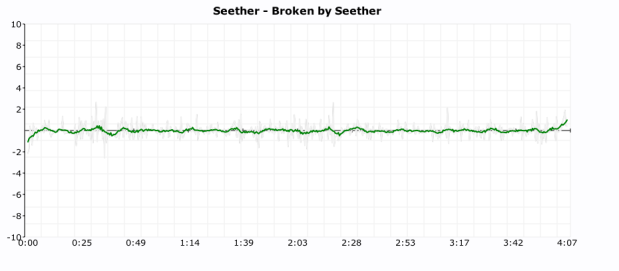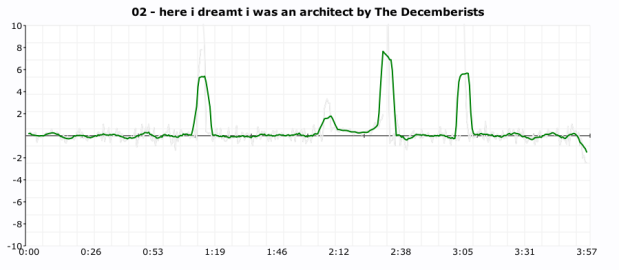One of my more popular posts from last year was ‘In Search of the Click track‘ where I posted some plots showing the tempo deviations from the average tempo for a number of songs. From these plots it was pretty easy to see which songs had a human setting the beat and which songs had a machine setting the beat (be it a click track, drum machine or an engineer fitting the song to a tempo grid). I got lots of feedback along with many requests to generate click plots for particular drummers. It was a bit of work to generate a click plot (find the audio, upload it to the analyzer, get the results, normalize the data, generate the plot, convert it to an image and finally post it to the web) so I didn’t create too many more.
Last week Brian released the alpha version of a nifty new set of APIs that give access to the analysis data for millions of tracks. Over the weekend, I wrote a web application that takes advantage of the new APIs to make it easy to get a click plot for just about any track. Just type in the name of the artist and track and you’ll get the click plot – you don’t have to find the audio or upload it or wrestle with python or gnuplot. The web app is here:
Here are some examples of the output. First up is a plot of “I love rock’n’ roll’ by Britney Spears. The plot shows the tempo deviations from the average song tempo over the course of the song. The plot shows that there’s virtually no deviation at all. Britney is using a machine to set the beat.
Now compare Britney’s plot to the click plot for the song ‘So Lonely’ by the Police:
 Here we see lots of tempo variation. There are four main humps each corresponding to each chorus where Police drummer Stewart Copeland accelerates the beat. Over the course of the song there is an increase in the average tempo that build tension and excitement. In this song the tempo is maintained by a thinking, feeling human, whereas Britney is using a coldhearted, sterile machine to set the tempo for her song.
Here we see lots of tempo variation. There are four main humps each corresponding to each chorus where Police drummer Stewart Copeland accelerates the beat. Over the course of the song there is an increase in the average tempo that build tension and excitement. In this song the tempo is maintained by a thinking, feeling human, whereas Britney is using a coldhearted, sterile machine to set the tempo for her song.
For some types of music, machine generated tempos are appropriate. Electronica, synthpop and techno benefit from an ultra-precise tempo. Some examples are Kraftwerk and The Postal Service:

 But for many songs, the tempo variations add much to the song. The gradual speed up in Jefferson Airplane’s White Rabbit:
But for many songs, the tempo variations add much to the song. The gradual speed up in Jefferson Airplane’s White Rabbit:
and the crescendo in ‘In the Hall of the Mountain King’:
 And in the Rolling Stone’s Sympathy for the Devil
And in the Rolling Stone’s Sympathy for the Devil
It is also fun to use the click plots to see how steady drummers are (and to see which ones use clicktracks). Some of my discoveries:
Keith Moon used a click track on ‘Won’t Get Fooled Again’:
 (You can see him wearing headphones in this video)
(You can see him wearing headphones in this video)
It looks like Neil Peart uses a click track on Stick it out:
Art Blakey can really lay it down without a click track (he really looks like a machine here):
 As does Ginger Baker (or does he use a click?):
As does Ginger Baker (or does he use a click?):
It seems that all of the nümetal bands use clicks:
Breaking Benjamin
Nickelback
 As do some of the indie bands:
As do some of the indie bands:
The Decemberists
I find it interesting to look at the various click plots. It gives me a bit more insight into the band and the drummer. However, some types of music such as progressive rock – with its frequent time signature and tempo changes are really hard to plot – which is too bad since many of the best drummers play prog rock.
In addition the plots I attempted a couple of objective metrics that can be used to measure the machine like quality of drummer. The Machine Score is a measure of how often the beat is within a 2 BPM window of the average tempo of the song. Higher numbers indicate that the drummer is more like a machine. This metric is a bit troublesome for songs that change tempo, a song that changes tempo often may have a lower machine score than it should. The Longest run of machine like drumming is the count of the longest stretch of continuous beats that are within 1BPM of the average tempo of the song. Long runs (over a couple hundred beats) tend to indicate that a machine is in charge of the beat. Both these metrics are somewhat helpful in determining whether or not the drumming is live, but I still find that the best determinate is to look at the plot. More work is needed here.
The new click plotter was a fun weekend project. I got to use rgraph – an HTML5 canvas graph library (thanks to Ryan for suggesting client-side plotting), along with cherrypy, pound and, of course, the Brian’s new web services. The whole thing is just 500 lines of code.
I hope you enjoy generating your own click plots. If you find some interesting ones post a link here and I’ll add them to the Gallery of Drummers.










#1 by Brian McFee on February 8, 2010 - 7:43 pm
Do you have any “least-machine-like” examples? The best I could find so far is Jimmy Chamberlain at 19%:
http://labs.echonest.com/click/?trackId=TRVDYBE12548892861&artist=The+Smashing+Pumpkins&title=Silverfuck
#2 by Michael Levine on February 9, 2010 - 4:58 pm
Click tracks go back further in pop music than many people realize. The Beatles made extensive use of them, most famously on A Day In The Life. But an artful use of a tempo map – one that might include speed changes both gradual and sudden – might register as “human” using your criteria. For example, most film and TV scores are tempo mapped. This practice goes back at least to the 1950s and, I believe, maybe ten or twenty years before. And yet many scores very sophisticated tempo shifts.
#3 by Ian K. on February 9, 2010 - 10:58 pm
Speaking of “click tracks” of a sort: Legend has it that the finger snapping on Tennessee Ernie Ford’s “16 Tons” were laid down by Ernie to help the band stay in tempo with him. They were supposed to remove the snaps afterwards, but they were inadvertently left in. The results: one of the biggest hits Capitol Records ever had.
#4 by Scott Bricklin on February 10, 2010 - 4:29 pm
very interesting!
#5 by Nick on February 15, 2010 - 7:16 am
I’m not sure that electronica etc “benefit from an ultra-precise tempo”, but the steady tempo makes it much easier for DJs to rearrange tracks on the fly. The DJ may change the tempo in performance later.
Any one track would probably benefit from some changes in tempo but unlike the other genres, the source track isn’t necessarily the final product.
Can’t think of a similar excuse for numetal – I suppose if the album is heavily produced then having all the parts recorded separately against a click track gives more freedom in post.
#6 by music is magic on February 15, 2010 - 11:52 am
as a drummer myself and having seen Ginger Baker live a few times, i’m willing to bet he doesn’t use a click track. he is just rock steady.
#7 by Ninja on February 15, 2010 - 6:20 pm
If you can’t tell with your ears, who cares?!
#8 by Doug on February 15, 2010 - 8:07 pm
Don’t forget about quantizing individual hits after the fact. That’s huge in metal. A lot of the hyper modern stuff has even more to do with quantizing than click tracks, thus the difference between Peart, and phenomenally tight drummer, and Breaking Benjamin.
#9 by Catharsis Studios on May 26, 2010 - 4:32 am
this is so far off its hillarious it doesn’t take notice of tempo changes i mean hell it even said attack attack stick stickly was 75% which those drums are 100% programmed